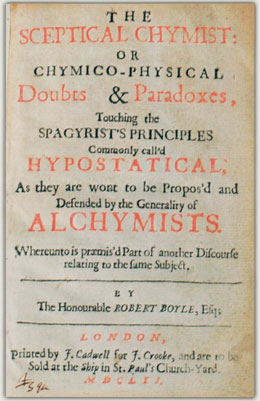Highlights

BOYLE, Robert (1627-1691)
The sceptical chymist: or chymico-physical
Doubts & Paradoxes
London: J. Cadwell for J. Crooke, 1661.
 F
F
irst edition of a milestone in the history of chemistry and a masterpiece of scientific literature. Written in the form of a dialogue, The sceptical chymist presented Boyle's hypothesis that matter consisted of atoms and clusters of atoms in motion and that every phenomenon was the result of collisions of particles in motion. Boyle suspected that none of the then accepted elements - the earth, air, fire and water of the Aristotelians; or the salt, sulphur, and mercury of the Paracelsans- was truly elementary: In this work he also defended his corpuscular chemistry, which was first clearly published earlier the same year. The importance of Boyle's book must be sought in his combination of chemistry with physics. His corpuscular theory and Newton's modification of it, gradually led chemists towards an atomic view of matter. Boyle distinguished between mixtures and compounds and tried to understand the latter in terms of the simpler chemical entities from which they could be constructed. His argument was designed to lead chemists away from the pure empiricism of his predecessors and to stress the theoretical, experimental and mechanistic elements of chemical science. The Sceptical Chymist is concerned with the relations between chemical substances rather than with transmuting one metal into another or the manufacture of drugs. In this sense the book must be considered as one of the most significant milestones on the way to the chemical revolution of Lavoisier in the late eighteenth century.

